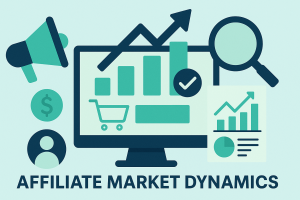
Share
Sometimes we all need to go back to the basics. Whether it’s the fundamentals of cooking, astrophysics, or affiliate marketing, starting from the top can be a big help. Well, I can’t speak for that middle one, but it couldn’t hurt, right? In that spirit, let’s get down to the brass-tacks of the affiliate space.
Affiliate marketing programs are similar to a recipe. There are four “ingredients” that make affiliate marketing everything that it is. But, for the sake of not referring to food for the rest of the post (would that be so terrible?), let’s just call them parties. Each party truly lends itself to the next, so let’s kick this guide off by outlining all of them:
- The Advertiser: Also known as the brand or merchant, advertisers sell a product or service. They can be big brand name companies or even solo entrepreneurs.
- The Affiliate: Also known as the publisher. This is the party that promotes the product or service for a commission of sales. They can range from bloggers, editorials, social influencers, loyalty/cash-back, shopping sites, coupon sites, and more.
- The Affiliate Network: The network serves as the middleman who connects advertisers with publishers, provides the tracking technology, and processes commission payments. Popular networks include CJ, Rakuten, Pepperjam/Partnerize, Impact, ShareASale, AWIN, and more.
- The Consumer: Simply the end-customers who purchase the product or service.
Knowing about each of these parties is vital to understanding affiliate marketing, but there’s more. One element of this system still needs to be talked about, so here I introduce the world’s smallest glossary:
- Affiliate Link: Special links created that direct potential consumers who click on them to an advertiser’s specific product, service, or website. When affiliates partner with advertisers and use these links on their channels, consumers can click on them and access whatever product or service is being promoted. After a consumer clicks an affiliate link and decides to make a purchase, the sale is then tracked. With the sale being tracked, advertisers then know to pay the affiliates a commission for making that particular sale happen through their platform.
Boom. Now we have what we need to get started. Alright, I know what you might be thinking. We haven’t even started getting into this yet and we already have a glossary of terms? Sheesh. Trust me, it’ll be worth it. But before we get “into it, into it,” what the heck is affiliate marketing? Well, I thought you might ask, so here’s the closest thing to a textbook definition:
Affiliate marketing is a process by which an affiliate earns a piece of profit—otherwise known as commission—for promoting and selling an advertiser’s products or services through their channel. This type of marketing is known as performance-based marketing, meaning that if and only if a sale is made does an affiliate get paid by an advertiser.
Who benefits from affiliate marketing?
So glad you asked! In that definition above, I talk about how affiliate marketing is performance-based. What that means is that the affiliate will only get paid if a consumer makes a purchase through their affiliate link. With this performance-based marketing method, advertisers are only charged by the affiliate once a sale is confirmed and after they receive money from the consumer. This ensures cash flows for both the advertiser and affiliate are protected. What this also tells us is that affiliate marketing encourages low-risk, mutually beneficial relationships between advertisers and affiliates.
Affiliate marketing enables you to generate more sales by tapping into other people’s audiences. These people or ‘affiliates’ earn a commission for referring customers, so it’s in their interest to write positive reviews and spread word of mouth. They’ll often write blog and content posts, promote your product on social media, and share it with their email list to earn higher commissions. The best affiliates will leverage their social network, unique audiences, and their affiliate sites to generate the most amount of exposure possible for the brands they are promoting.
A Pepperjam affiliate marketing study by Forrester found that advertisers with affiliate programs believe the channel drives significant revenue and customer acquisition for their companies. They report higher-quality prospects and improved revenue from existing customers. Because affiliate programs are paid on performance, transparency is always a benefit. Not to mention, those advertisers also feel that the channel is less affected by things like brand safety, fraud, and ROI visibility than other marketing mediums that use a pay-for-access model.
At Advertise Purple, we know 92% of our customers rate our agency and affiliate marketing as critical to their business objectives, according to our client poll.
Another benefit is that it allows advertisers to reach a much wider geographic audience through an affiliate’s channel. If your business sells internationally, for example, then you can recruit affiliates from all over the world to promote your products or services. Instead of needing to invest tons of money in a marketing agency for this outreach, affiliates will produce localized promotional content on your behalf. They’ll know exactly the keyword terms to use to target search engines and you can save your marketing funds instead of sourcing expensive translators. If you’re an advertiser, your revenue simply increases with each confirmed sale an affiliate facilitates.
How does it work?
So, we’ve already gotten the core elements of the affiliate program down. Yes! But let’s talk about the journey involved here with each of them. You can almost think of affiliate marketing as a cycle in which one thing leads to the next and then back around at the end. It’s a little hard to paint this visual with words, so let’s just start from the top. Sound good? Fantastic.
- An affiliate introduces consumers to the products or services of an advertiser that they choose to work with. How? Well, it could take place in numerous ways, but all of them involve including an affiliate link on their channel. These promotions could look like ads, writing a gift guide on a blog and featuring an advertiser’s product, sharing that product on their YouTube channel, including it in a product review, or placing it on a coupon website, just to name a few.
- A customer gets curious about the product or service and decides to click on the affiliate link.
- The customer says, “Hmm, this product is cool,” and buys it on the advertiser’s website.
- An affiliate network records the purchase and the details of the transaction.
- The advertiser confirms the customer’s purchase as a valid sale and then credits the affiliate.
- The affiliate gets paid a commission for the sale they helped make possible.
This cycle goes on with each new product or service that an affiliate decides to market on their channel. That wasn’t so bad though, right? Now you can begin to see how everything comes together. Each of these parties works with the next and contributes to how affiliate marketing works as a whole.
Why should every e-commerce company use affiliate marketing?
A bold question, I know, but I’m willing to back it up with equally bold answers. Ready to learn about why affiliate marketing is a heavy hitter that e-commerce companies can benefit from? Let’s go.
- To start, affiliate marketing is a multi-billion dollar industry. Affiliate marketing spending in the U.S. alone is expected to rise to $8.2 billion by 2022—triple what it was a decade earlier.
- In 2020, online consumers spent $861 billion with U.S. merchants, up 44% year over year.
- Under Advertise Purple, clients have generated over $425 million in affiliate revenue last year with a 24% year over year increase in orders and a 24% increase in aggregate affiliate clicks.
- With affiliate marketing, brands generally see higher conversion rates, higher AOVs, and more orders per customer, which delivers an 88% higher revenue per shopper. In fact, 60% of revenue for some brands comes from recruited affiliates alone.
- A Pepperjam and Forrester affiliate marketing acquisition study reveals that 42% of affiliate marketers say their affiliate programs are successful, and 33% highly successful, at driving customer acquisition. 54% ranked affiliate marketing as an important channel for their organization’s customer acquisition efforts with 20% ranking it as the most important.
- 52% of marketers in the Pepperjam and Forrester study ranked their affiliate program as one of their top three revenue drivers with 19% ranking it as their top-performing channel.
- A Forrester report commissioned by Rakuten found that 81% of advertisers and 84% of affiliates use affiliate marketing. Over half of the advertisers surveyed in this report said that affiliate marketing accounted for more than 20% of their annual revenue.
What does the future of the affiliate channel look like?
You don’t need to go through many of those stats to grasp that affiliate marketing is one of the fastest-growing channels and that the affiliate space is performing well. No matter which party you belong to—advertiser, affiliate, or network—the future looks good for affiliate marketing in the years and even the decade ahead. All of this points to the channel being a true win-win for all involved.
To wit, when advertisers think about their affiliate marketing program, Pepperjam and Forrester say 53% associate it with enhancing their loyalty efforts, 52% with high-quality customer prospects, 48% with increasing revenue from existing customers, 46% with greater control over media spend vs other channels and 45% with improved marketing ROI compared to other marketing mediums.
If you’re still wondering about what affiliate marketing is or have questions about its benefits, how it works, and the first steps to get started, we can help. Our digital marketing team specializes in this area and is always up-to-date with the latest affiliate management technologies. Our program managers can advise you on the best approach for your business, whether you’re a small startup or a large enterprise.
For new partnerships and affiliate management inquiries, please email:



